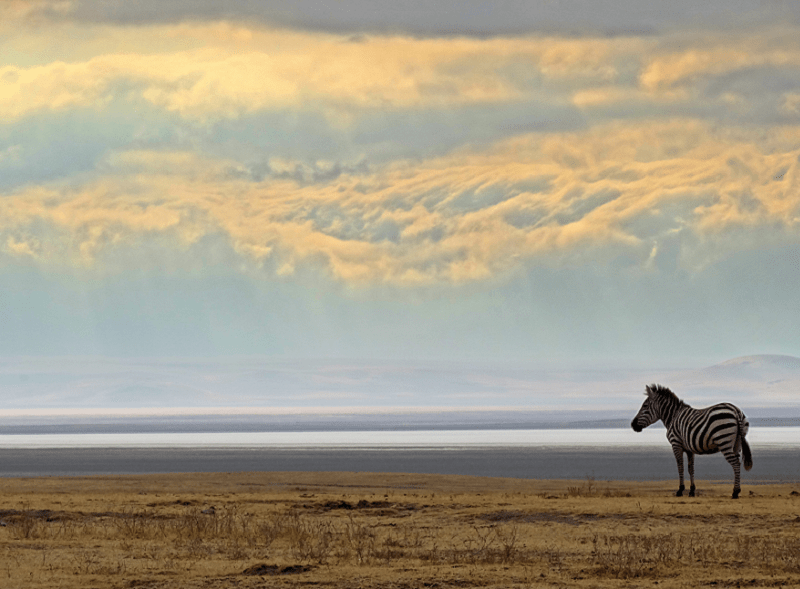
Ngorongoro Crater Facts
- This breathtaking creation of geological forces remains best known by the somewhat hard to pronounce term of Ngorongoro Crater. It stands out due to the fact that it represents the largest inactive, intact, and unfilled volcanic caldera on earth.
- Evidence indicates that this masterpiece of Nature formed somewhere between 2 – 3 million years ago. This occurred due to the powerful explosion of a large volcano. The remnants of the mount subsequently collapsed inward, forming the site as it is now.
- Researchers currently estimate that the original volcano boasted a height between 14,800 – 19,000 ft (4,500 – 5,800 m). The formation as it exists now holds some truly impressive physical dimensions. Its floor measures roughly 2,000 ft (610 m) in depth.
- The crater remains relatively circular in shape. It also measures about 12.4 mi (20 km) in diameter. The floor of this remarkable product of natural forces also distinguishes itself. That’s because it covers an area of about 100 sq mi (260 sq km).
- That same portion of Ngorongoro Crater further separates itself from similar features. The crater does so due to yet another surprising characteristic. The tantalizing wonder of geology lies at an elevation of around 5,900 ft (1,800 m) above sea level.
Related Articles




Ngorongoro Crater Wildlife
The lush setting of Ngorongoro Crater literally teems with life. This includes both plants and animals, to be certain. Yet it’s the fauna that make their home here that garner the most attention. These comprise an incredible variety of animals, both large and small.
Roughly 25,000 large animals live within its confines. Ungulates comprise the majority of these, though. This population includes such animals as the black rhino, hippo, and the cape buffalo. Wildebeests, zebras, elands, gazelles, and other herbivores also appear.
A relatively large lake also exists in the southwestern portion of the beautiful formation. Named Lake Madagi, it’s frequently filled with large numbers of lesser flamingoes. Other avians also appear in small numbers. One endangered species of shrew also lives there.
Intriguingly, many other creatures common to this part of the world remain absent. Whether that’s coincidental or due to some unknown factor remains undetermined. Impala, giraffe, oribi, and topi do not live here. Among predators, crocodiles are curiously absent.
Given the presence of so many potential prey species, many predators call the location home, too. It holds one of the densest known population of lions. They’re not the only large feline present, though. Servals additionally dwell in comparatively large numbers here.
Some additional creatures do appear in Ngorongoro Crater sporadically, however. These include such creatures as the African leopard, East African wild dog, and the cheetah. Some of the many animals here seem to migrate in and out of the amazing site, as well.

Ngorongoro Crater Location, History, and Preservation
The location of the magical Ngorongoro Crater suits it perfectly as a backdrop for its wonders. That’s due to the fact that it formed in a region of the globe renowned for its many natural marvels. More specifically, it sits on the already impressive continent of Africa.
There, it formed on the approximate southeastern section of the landmass. That location places it inside the boundaries of the country of Tanzania. It further sits roughly 110 mi (177 km) west of Arusha City. This places it in the aptly-named Crater Highlands of the country.
Archaeological evidence indicates that prehistoric man knew of this wonder in the far-distant past. Fossil discoveries show that various hominid species have occupied the region for more than 3 million years! Pastoralists replaces hunter-gathers a few thousand years ago.
In more modern times, the Mbulu arrived in the region around 2,000 years ago. The Datooga joined them around 1700 years later. Yet another Indigenous People displaced both in the 1800’s. That group, the Maasai, still inhabit the immediate area of the site.
Efforts to preserve and maintain the vital Ngorongoro Crater remain ongoing. For one, it now forms part of the namesake Ngorongoro Conservation Area. In fact, this entire marvel of geology presently officially qualifies and lists as a UNESCO World Heritage Site.
Features Sharing Its Range



Check out our other articles on 4 Fabulous New Zealand Flora, Baatara gorge waterfall, Dead Man’s Fingers, California Sea Lion, California Mantis, Goldentail moray, Satanic Leaf-Tailed Gecko









Leave a Reply